As one of the only big cats that live in groups, lions are social and live in an egalitarian society without ranking.
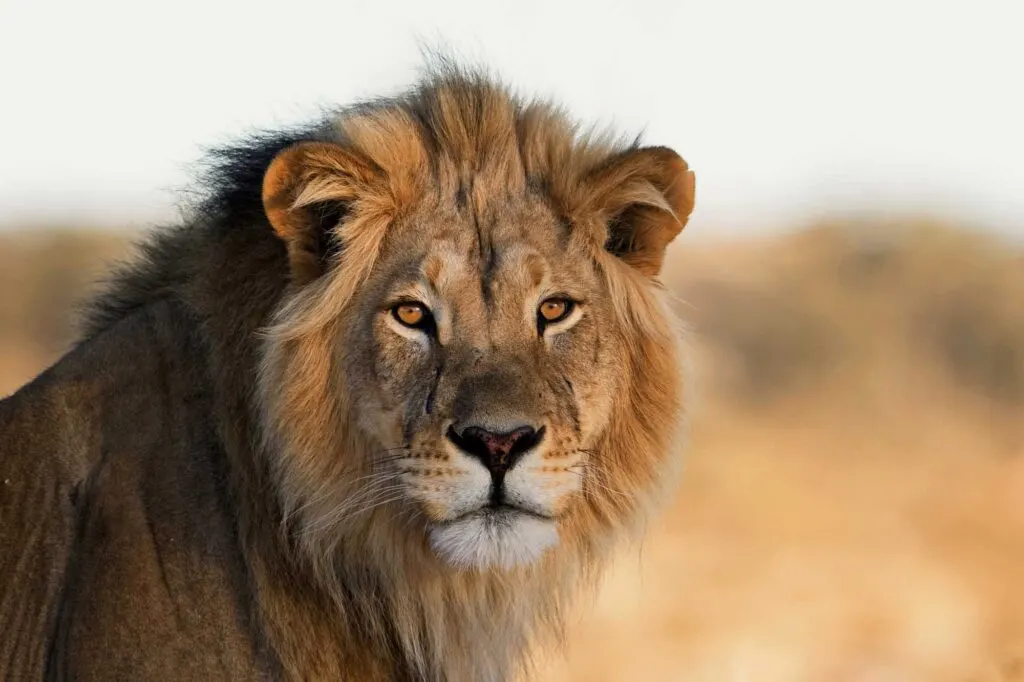
African Lion
Panthera leo
African Lion Scientific Classification
- Kingdom: Animalia
- Phylum: Chordata
- Class: Mammalia
- Order: Carnivora
- Family: Felidae
- Genus: Panthera
- Species: Panthera leo
African Lion Appearance
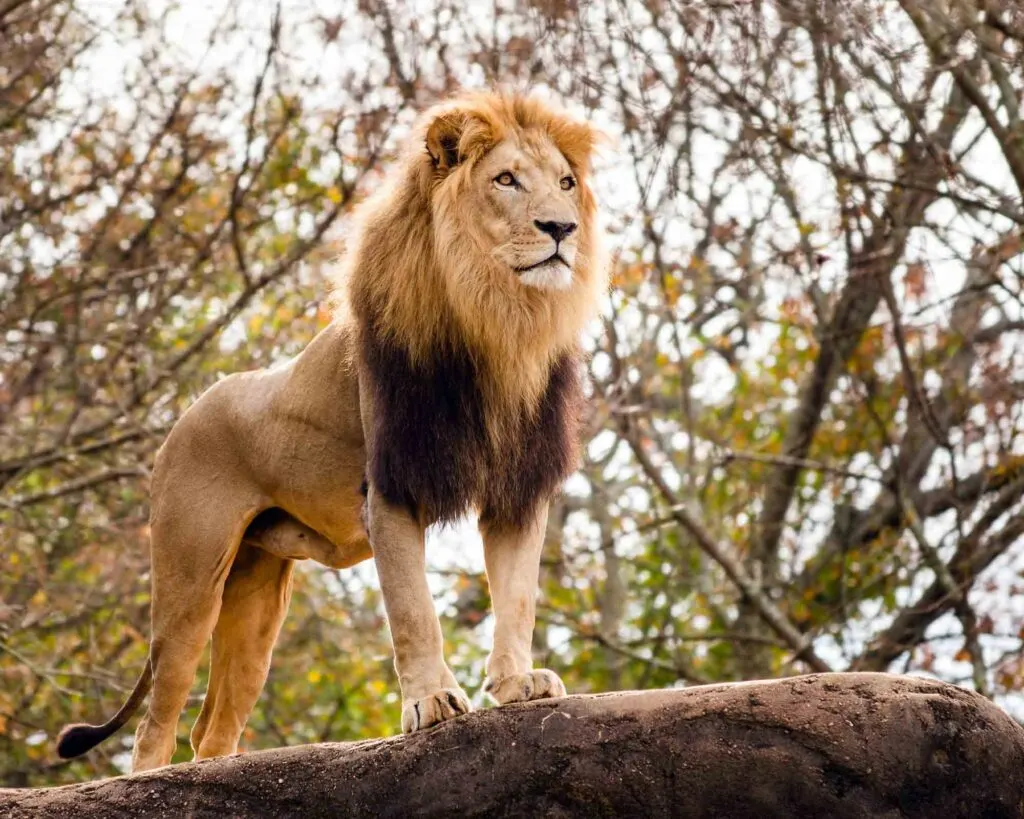
- Lifespan: 15 years
- Length: Head and body, 5.2 to 6.8 feet; tail, 2.3 to 3 feet
- Height: 3.6 to 3.9 feet
- Weight: 265 to 420 pounds
- Top speed: 50 mph – among the top fastest land animals!
As one of the big five animals, lions are muscular cats with round heads and short necks. Of all the big cats, lions are rivaled only by tigers when it comes to length, weight, and height.
While the range and habitats affect the dimension of lions, on average, they are 5.2 to 6.8 feet in length, 265 to 420 pounds in weight, and 2.3 to 2 feet in tail length.
The fur color varies from light buff to silvery grey, yellowish red, and dark brown. The underparts are generally paler. A newborn lion has dark spots that eventually fade, leaving behind faint marks seen on its legs and underparts.
The male and female lions are easily distinguishable. Males have broader frames with a prominent mane, usually brownish with hints of yellow, rust, and black. The color may darken with age.
The tails of these wild cats of Africa end with dark, hairy tufts. In some lions, this section keeps hidden a hard ‘spine’ or ‘spur’ formed from the fusion of the final sections of the tail bone.
Did you know? The name for lion in Swahili, an African language, is “simba.”
African Lion Range & Habitat
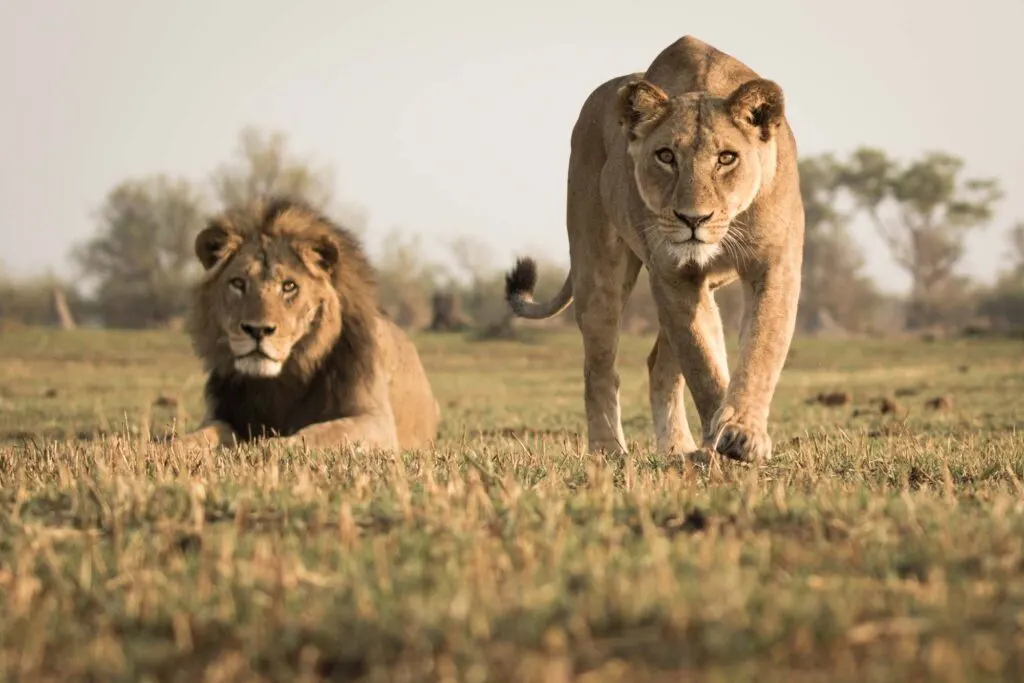
Lions were once widely distributed globally but have significantly reduced in numbers.
Now, they can only be found spread throughout most of Africa, from the Sahara’s southern fringe to northern South Africa, the Middle East, and the Indian subcontinent.
Lions prefer grassy plains and savannas. They are often found in scrubs bordering rivers and in open woodlands with bushes.
The African lion population is scattered across Sub-Saharan Africa. Lions are absent from rainforests and closed forests.
Distribution
- Continents: Africa, Asia
- Countries: Angola, Benin, Botswana, Burkina Faso, Cameroon, Central African Republic, Chad, DR Congo, Ethiopia, India, Kenya, Malawi, Mozambique, Namibia, Niger, Nigeria, Senegal, Somalia, South Africa, South Sudan, Sudan, Swaziland, Tanzania, Uganda, Zambia, Zimbabwe, Cote d’Ivoire, Ghana, Guinea, Guinea-Bissau, Mali, Rwanda, Togo
Biome
Desert and Xeric Shrublands | Tropical Savanna
African Lion Behavior and Lifestyle
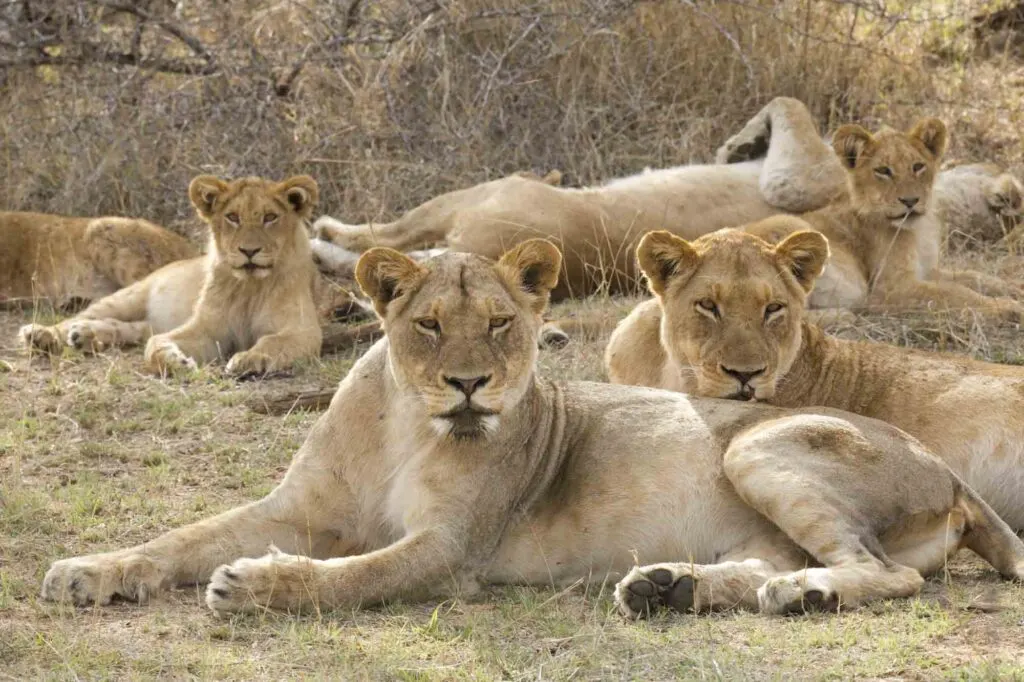
Lions are the most social big cats that prefer living in groups called ‘prides.’ These groups are made of 15 lions usually related, including several adult females, up to four males, and their cubs. However, a pride of 30 individuals has also been recorded.
However, Asiatic lion prides differ in group composition. Male Asiatic lions are solitary or associate with up to three males, forming a loose pride while females associate with up to 12 other females, forming a stronger pride together with their cubs.
These felids, African lions, spend most of their time resting, remaining inactive for twenty hours a day. They can usually be spotted after dusk, socializing, grooming, and defecating. Although, their main activity is after dawn when they set off to hunt.
African Lion Diet
Lions are carnivorous animals. They are at the top of the food chains and are labeled as apex predators because of their broad prey spectrum.
Their prey is made chiefly of mammals. However, they are partial to ungulates weighing roughly 420 to 1,210 lbs. This includes blue wildebeests, plains zebras, African buffaloes, gemsboks, and giraffes.
Lions also hunt the common warthogs. In India, the sambar deers, chitals, and livestock are most often their wild prey.
Lions avoid large targets like fully grown adult elephants, rhinoceroses, and hippopotamuses, and prefer smaller prey like dik-diks, hyraxes, hares, and monkeys.
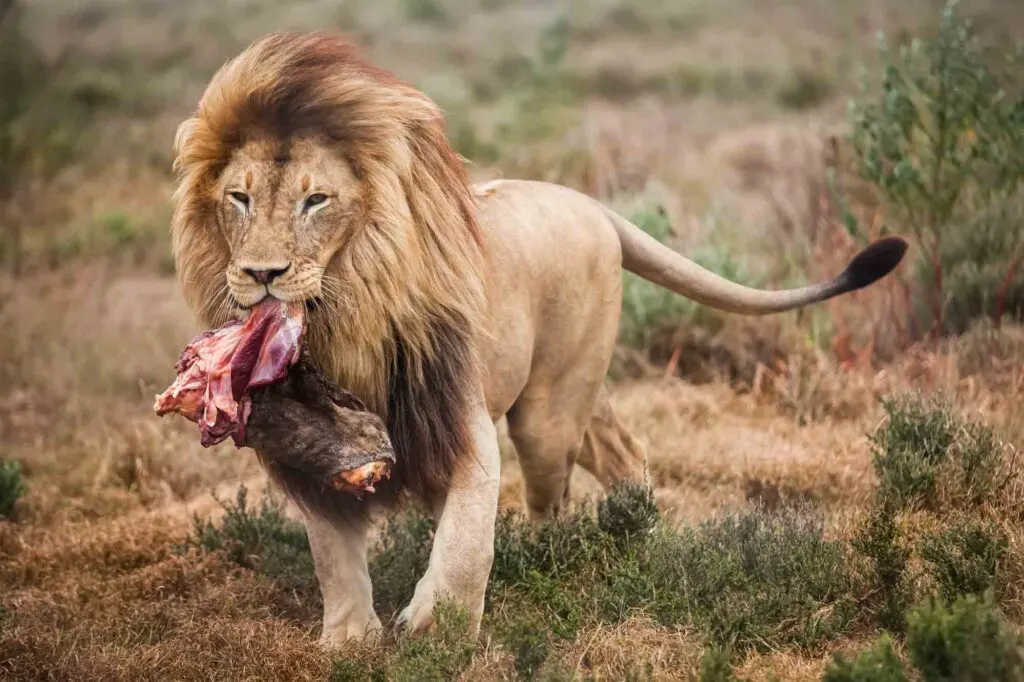
Occasionally, they may turn to unusual animals like porcupines and small reptiles. Lions finish their predators, such as leopards, cheetahs, and spotted hyenas but do not consume them.
Cubs first begin stalking prey at three months of age but do not participate in the hunt until they are a year old. They can effectively hunt at two years of age.
While single lions are capable of bringing down zebras and wildebeests on their own, larger targets such as buffaloes and giraffes require more effort. The adult males generally do not strike in groups, preferring to hunt in solidarity by ambushing animals.
On the other hand, in a typical hunt, each lioness tends to favor a specific position in a group. They will either stalk prey on the ‘wing’ then strike or move smaller distances in the center of the group and capture prey that tries to flee.
Lions lack stamina. So, they tend to stalk close to their prey and then run in short bursts before striking. Their strike is quick and powerful, attempting to catch the prey with a fast dash and final leap. Lions will pull down their targets by the rump and strangle by biting the throat.
African Lion Reproduction and Mating
Lionesses will start reproducing by the age of four years. These big cats do not have a set mating period, and the females are polyestrous.
The female lion might mate with more than one male while in heat. The generation length between births is usually seven years, while the regular gestation period is 110 days.
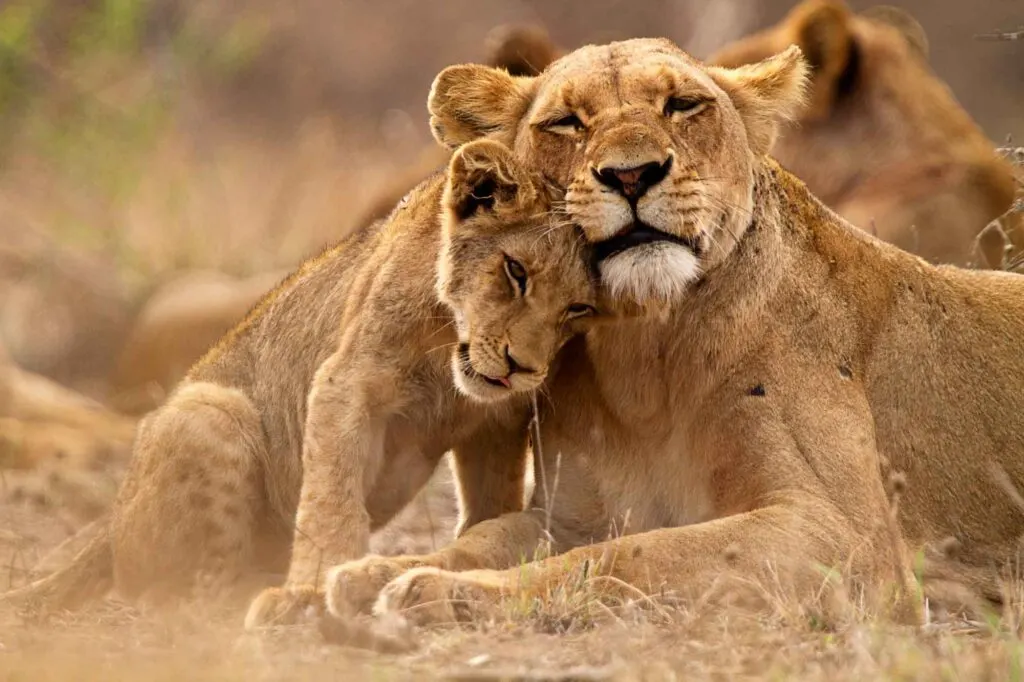
Lionesses give birth to litters of one to four cubs. They adopt secluded dens or caves as birthing grounds, away from the pride. The lion cubs are born blind and helpless.
They open their eyes seven days after birth and begin crawling a day or two after birth and walk at three weeks.
The female lion will hunt alone while her cubs are still young but remain close to the den. As a protective measure to avoid the buildup of scent that attracts predators, the lioness moves her cubs to a new den site multiple times every month. She carries them one by one in her mouth by the napes of their necks.
African Lion Conservation Status
Vulnerable[1]
African Lion Predators and Threats
Lions are at the top of the food chain and are the hunters rather than the hunted. They face competition from spotted hyenas that occupy a similar ecological niche as lions. So naturally, they coexist by competing for prey and carrion.
However, lions typically ignore spotted hyenas unless the lions are on a prey or are being harassed by the hyenas, while the latter tend to visibly react to the presence of lions, with or without the presence of food.
Lions dominate cheetahs and leopards, stealing their food and finishing their young ones, sometimes even adults, to establish superiority.
A similar tendency in lions can be seen while facing African wild dogs- stealing their prey and chasing on their young, rarely adult dogs. However, African wild dogs also retaliate, wounding and slaying lions.
These felids charge at Nile crocodiles when the opportunity arises. While fairly matched, the outcome of the battle is determined by the size of the opponents. Crocodiles that venture on land may prey on and eat lions.
African Lion Facts
Here are some interesting fun facts about lions worth knowing.
- Most lions are found in Africa, while a small population resides in the Gir National Forest of India.
- The manes of male lions grow darker and more impressive with age. They can grow up to 6.3 inches long and are a sign of dominance. In addition, they help in attracting female lions and protecting the neck and head from injury during a fight.
- Lions are very adaptable to even dry environments. They will get their water from their prey, even from plants like the Tsamma melon.
- White lions exist due to a genetic condition called leucism.
- Lions have a massive diet. They can consume up to 88 pounds of meat in a single meal.
- Lions hunt during the night as the dark reduces the visibility of prey. They tend to hunt during storms too to conceal their sounds while stalking.
- Lions are the only cats who roar together. Cubs will also join in the group calls, which can last for 40 seconds.
